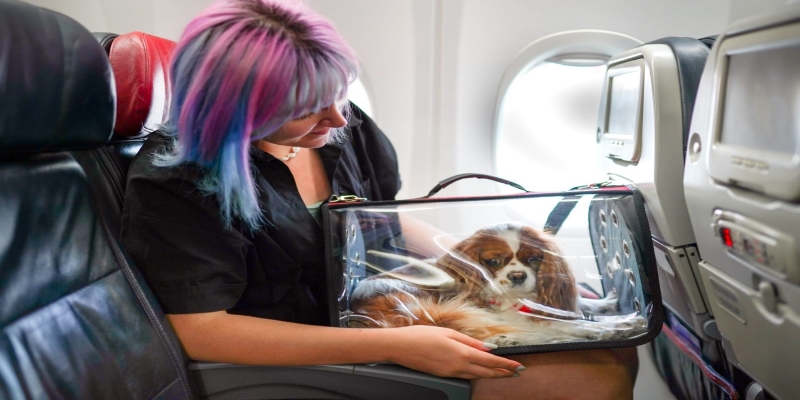Traveling with your dog can be an exciting adventure, but it also comes with its own set of challenges and uncertainties. One common concern among pet owners is whether theres a no-fly list for dogs, a term that often causes confusion and anxiety.
While the idea of a no-fly list might sound like a real concern, the reality is different. This article will clarify what pet travel restrictions really mean, debunk myths about no-fly lists, and provide practical advice to help ensure your dogs journey is as smooth and stress-free as possible.
When it comes to air travel, pets face a range of regulations rather than an outright ban. While the concept of a no-fly list for dogs is a misconception, there are specific rules and policies that airlines enforce to ensure pet safety and comfort. Understanding these regulations helps clarify what restrictions may apply and how you can effectively navigate them to make your pet's travel experience as smooth as possible.
The term "no-fly list" typically refers to a list of individuals prohibited from boarding flights due to security concerns. This concept, rooted in aviation security, is used to identify potential threats and prevent dangerous individuals from boarding aircraft. However, this kind of list does not apply to pets, including dogs. There is no official no-fly list specifically for dogs or other animals.

While there isn't a universal no-fly list for dogs, air travel for pets is governed by a variety of regulations and policies set by airlines, governments, and international bodies. These regulations are designed to ensure the safety and well-being of pets during flights. Different airlines have their policies regarding pet travel, which can include:
Breed Restrictions: Some airlines impose restrictions on certain breeds, particularly those considered high-risk due to their health or physical characteristics. For example, flat-faced breeds like Bulldogs or Pugs may face additional scrutiny because of their respiratory issues.
Size and Weight Limits: Many airlines have specific size and weight limits for pets traveling in the cabin. Pets that exceed these limits typically must travel as cargo.
Health Certifications: Airlines often require pets to have a health certificate issued by a veterinarian. This ensures that the pet is fit for travel and up-to-date on vaccinations.
Travel Containers: Pets traveling in the cabin must usually be placed in approved carriers that meet airline specifications. These carriers must be well-ventilated, secure, and comfortable for the pet.
In some cases, a pet might not be permitted to fly on a specific flight due to various reasons. If this happens, there are several steps you can take:

Contact the Airline: Contact the airline for clarification on their policies and to discuss possible alternatives. They might be able to offer solutions such as rebooking on a different flight.
Check for Alternative Airlines: If your current airline cannot accommodate your pet, consider other airlines that might have more flexible policies or better facilities for pet travel.
Consider Pet Shipping Services: For long-distance or international travel, specialized pet shipping services can provide additional support and ensure your pets safe transport.
Traveling internationally with pets involves additional complexities. Different countries have their regulations regarding pet importation, which can include:
Quarantine Requirements: Some countries require pets to undergo a quarantine period to ensure they are free from diseases.
Vaccination and Microchipping: Pets often need to be vaccinated against certain diseases and microchipped for identification.
Import Permits: Certain countries require import permits for pets. Its crucial to research and obtain any necessary documentation well in advance of your trip.
Traveling with your pet can be a rewarding experience, but it requires careful planning to ensure their safety and comfort. Here are some practical tips to make the journey easier for both you and your dog:
Start Early: Begin preparing for your trip well in advance. Familiarize yourself with the airlines pet policies and make arrangements for any required health certificates or vaccinations. The more time you have, the smoother the process will be.
Visit the Vet: Schedule a visit to the vet to ensure your dog is healthy and up-to-date on vaccinations. Obtain a health certificate if required by the airline or destination. This can help prevent any issues at the airport or with customs.
Pack Essentials: Pack a travel bag for your dog with its favorite toys, blanket or bedding, food, water, and any medications it may need. Having familiar items can help reduce their anxiety and make them feel more secure.
Comfort and Hydration: Keep your dog comfortable and hydrated during the trip. If your pet is traveling in the cargo hold, ensure it has access to water and is placed in a climate-controlled environment.
Plan for Breaks: If you're traveling a long distance, plan for regular breaks to allow your dog to stretch, relieve themselves, and get some fresh air. This is especially important if they are traveling as cargo.
Stay Calm: Dogs can pick up on their owner's stress, so try to stay calm and positive. Your demeanor can help keep your pet relaxed and more comfortable during the trip.
Know the Regulations: Be aware of any travel regulations for your destination, especially if traveling internationally. Some countries have specific entry requirements for pets, such as quarantine or additional vaccinations.
There is no official no-fly list for dogs. Still, air travel for pets is subject to various regulations and airline policies designed to ensure their safety. Understanding these rules and preparing accordingly can help make your pet's travel experience as smooth as possible. By planning, staying informed, and choosing the right airline and services, you can help ensure a safe and comfortable journey for your furry companion. Whether you're traveling domestically or internationally, being aware of and adhering to pet travel regulations is key to a successful trip with your dog.

By Susan Kelly/Aug 29, 2024

By Kelly Walker/Jul 13, 2024

By Isabella Moss/Aug 30, 2024
By Martina Wlison/Sep 04, 2024

By Maurice Oliver/Aug 29, 2024

By Darnell Malan/Sep 04, 2024

By Kristina Cappetta/Sep 04, 2024

By Pamela Andrew/Sep 04, 2024

By Jennifer Redmond/Sep 04, 2024

By Juliana Daniel/Sep 03, 2024

By Celia Shatzman/Sep 04, 2024

By Elena Davis/Sep 04, 2024